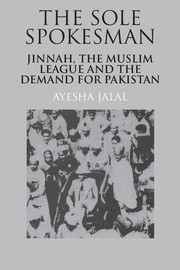Book contents
- Frontmatter
- Contents
- List of maps
- Preface
- Preface to the paperback edition
- List of abbreviations
- 1 Muslims 1931. Data by minor administrative subdivisions and major administrative divisions
- 2 Major administrative divisions
- Introduction
- 1 Jinnah between the wars
- 2 Jinnah and the League's search for survival
- 3 Jinnah and the Muslim-majority provinces
- 4 Centre and province: Simla and the elections of 1945–46
- 5 Jinnah's ‘Pakistan’ and the Cabinet Mission plan
- 6 The interim government: Jinnah in retreat
- 7 The end game: Mountbatten and partition
- Glossary
- Select bibliography
- Index
5 - Jinnah's ‘Pakistan’ and the Cabinet Mission plan
Published online by Cambridge University Press: 01 June 2011
- Frontmatter
- Contents
- List of maps
- Preface
- Preface to the paperback edition
- List of abbreviations
- 1 Muslims 1931. Data by minor administrative subdivisions and major administrative divisions
- 2 Major administrative divisions
- Introduction
- 1 Jinnah between the wars
- 2 Jinnah and the League's search for survival
- 3 Jinnah and the Muslim-majority provinces
- 4 Centre and province: Simla and the elections of 1945–46
- 5 Jinnah's ‘Pakistan’ and the Cabinet Mission plan
- 6 The interim government: Jinnah in retreat
- 7 The end game: Mountbatten and partition
- Glossary
- Select bibliography
- Index
Summary
Section 1
After the 1945–46 elections the lines were clearly drawn for the claims and counter-claims of the end game. Congress still wanted independence to come before settling the communal problem. This meant having an essentially unitary form of government – one constitution and one nation – strong enough to fulfil the purposes for which independence was being sought, while appeasing the fears of provinces and minority groups. In contrast, Jinnah and the League reiterated their demand that the first step must be to accept Pakistan in principle now that the Muslim electorate had given its verdict in favour of it. Once Congress was prepared to recognise this, ‘the whole spirit would change and we should become friends’. If the British then ‘declared their decision in favour of Pakistan there would be no trouble’ since the ‘Hindus would quickly accept it’.
Another British initiative was now inevitable, and Congress at any rate wanted to speed up matters. Seeing this, Jinnah had to show a little more of his hand: the principle of Pakistan, he now explained, meant that the old unitary centre of British India had to be replaced by two distinct and separate political entities or federations organised by two constituent assemblies, one for the Muslim provinces and the other for the Hindu provinces.
- Type
- Chapter
- Information
- The Sole SpokesmanJinnah, the Muslim League and the Demand for Pakistan, pp. 174 - 207Publisher: Cambridge University PressPrint publication year: 1985
- 1
- Cited by



